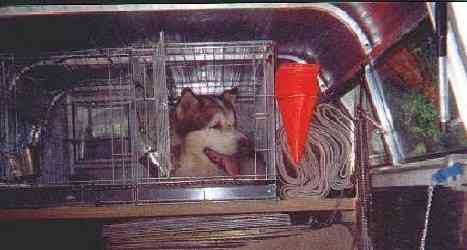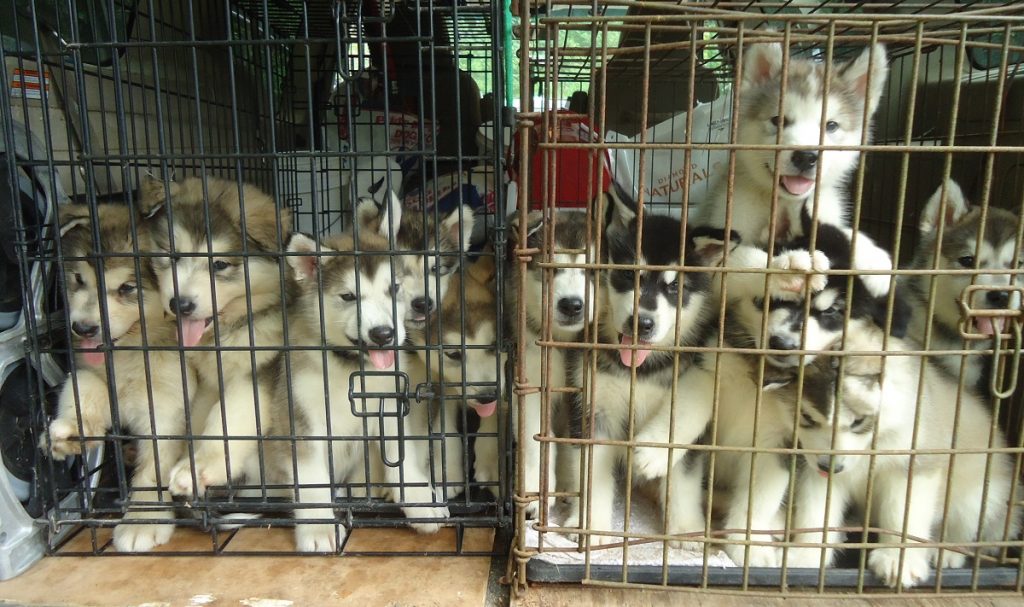It is not unusual for dogs to have behavior problems related to the car. Usually it is car sickness, fear, unruly or territorial behavior, and chasing cars.
Car Sickness & Fear
If your dog is either fearful of car rides or gets car sick, then you must show your dog that there is nothing to be afraid of and no reason to be sick. Many dogs associate car rides with something unpleasant or with previously being carsick. Reintroduce the car to the dog again slowly and in a non-stressful way.

Start out by just feeding the dog in the car. You can even put the food bowl next to the wheel of the car to start out. Then open the door and place the bowl in the floorboard. Then inside with the door closed. Then inside with the door closed… and start the engine.
Some dogs can learn to love a car just by being in the car with the owner, sitting there, reading a book, not going anywhere. Not even starting the motor. Just sit in there and read a book or listen to the radio.
But most dogs who are fearful or anxious need something more. And Malamutes will work for food!
Soon the dog will realize that nothing terrible has happened and that it did not get sick. Keep doing this until the dog is obviously relaxed and not fearful. If the dog does get sick, then you’ve stayed too long and should begin for shorter periods. When you see that your dog is comfortable with this activity, progress a little further and start the engine, but still do not go anywhere. When the dog is relaxed with the motor running, then begin taking very short trips, perhaps just around the block.

As your dog gets more and more comfortable, go for longer rides. Drive to places where the dog has fun. Take a short ride up the block to the dog’s favorite walking area or to the beach, park or a friend’s house. Let the dog associate car rides with fun, pleasant and rewarding experiences.
Do not rush the dog into anything, or it may just slow down the process even further.
Some dogs associate the car with good times to the point of becoming overly excited. In this case, begin taking the dog for short rides that do not end up at the park or beach, but back home again. Teach your dog some obedience commands like down-stay. Sit in the car with your dog and practice there. Start out on a quiet street. Obviously do this with the car parked. You cannot drive and train the dog at the same time. Once the dog has mastered the down stay, then begin practicing in more distracting places. Make sure your dog can and will obey before giving the command in rush-hour traffic.
Make sure your dog is SAFE in your car with a crate (preferred) or a safety harness. Crates are safer and easier to clean in case of an “accident” in the car.

Unruly or Territorial Behavior
If the dog is crated in the car, his behavior can only get so unruly or territorial. It will be a pain to deal with, but he won’t be a danger to anyone if he’s securely crated.
But still it’s unacceptable behavior and makes for a poor Ambassador for the breed. So teach a down stay outside the car, then in the car when it’s not moving, then in the car when there are no distractions, then add distractions. Gradually working longer down-stays before you increase the stimulus. If a dog doesn’t like going to the vet because of an unpleasant experience, I give the dog plenty of good experiences to overrule the bad ones. If the dog goes to the vet 12 times in a year and has 10 great experiences with treats and pats, then shots won’t be a problem. Especially if you pile on the treats and pats from everyone who will take a treat from you and give it to the puppy. Same theory goes for car rides. Make it the place where the fun happens and poor behavior will melt away.
Noise makers and scent aversions can be useful to break the stupid thoughts if the dog gets into a bad behavior pattern, but bottom line, who is in charge here? The one who pays the mortgage or the one who eats the couch? Training, repetitive training, lots of training is how you get that point across to the unruly pup.
A territorial dog, in the car or elsewhere, is a different set of training issues and starts with a baseline fear or aggression that has to be addressed by a professional.
Chasing cars
This one is dirt simple. All 50 states have ordinances that require dogs be contained on the owner’s property or under the owner’s verbal control. If your dog is chasing cars he’s not under your control and he’s not contained.
Build a fence.
Use it.
If the dog is chasing your cars, endangering himself, it is a training issue and you can address it with a training session that includes setting the dog up and then aversion training with noise makers or scent aversions. Train this problem the same way you’d train any unwanted behavior. Manage the dog’s behavior, redirect/refocus the dog’s behavior, and don’t put the dog in dangerous situations in the first place.
